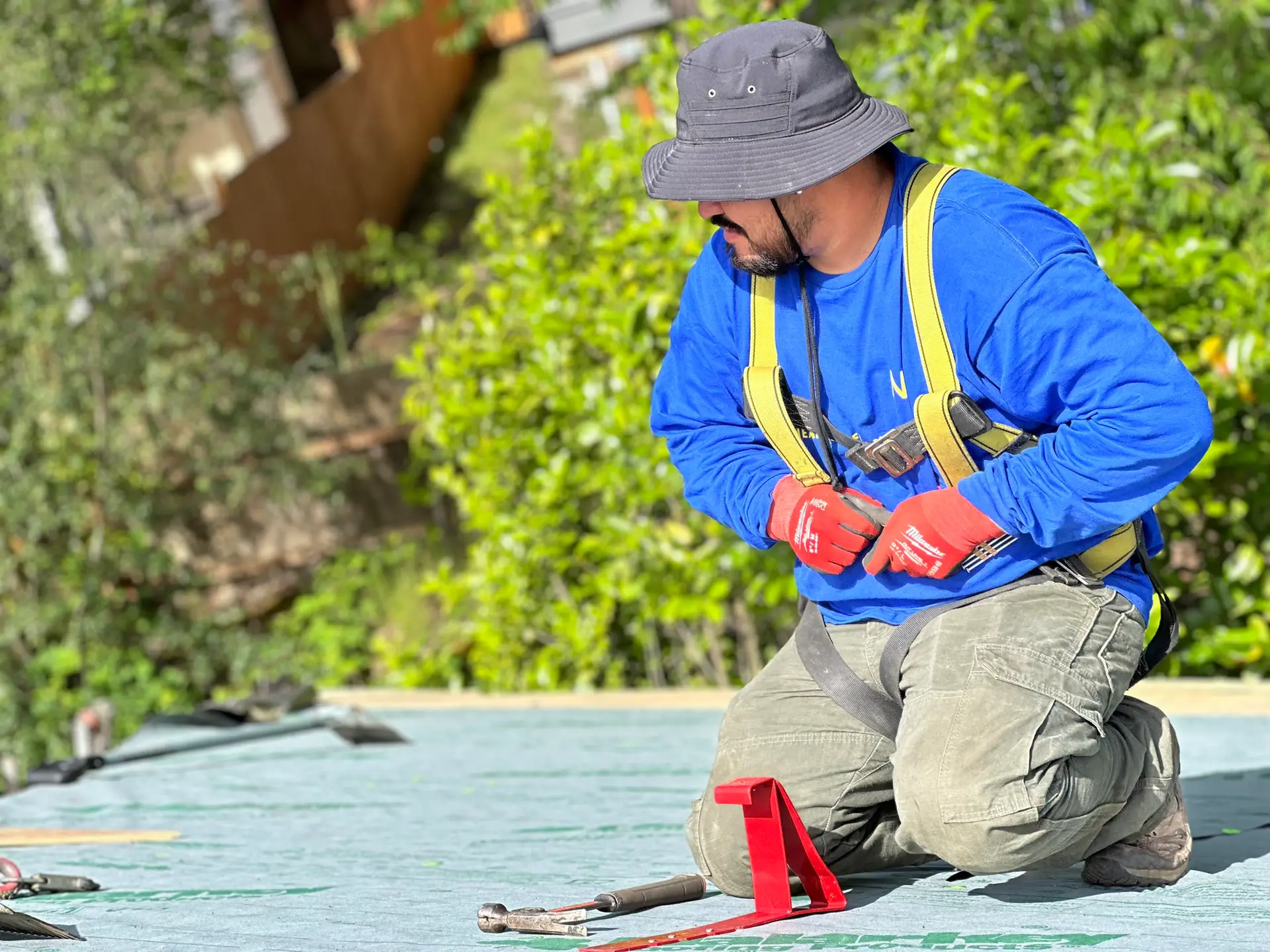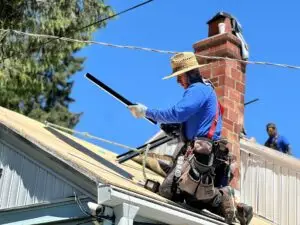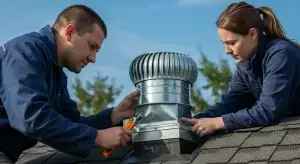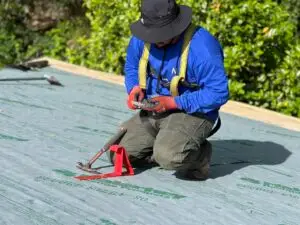Your roof’s supposed to protect your home, not create more problems. But what if your new roof is already showing signs of trouble? Poor installation is more common than you realize, turning what should be a decades-long investment into structural damage and financial drain. And in a wet climate like Seattle’s, small issues can quickly spiral out of control.
But knowing how to catch signs of a botched roof replacement early on can save you a lot of money and stress. Here are ten warning signs that your roof replacement is taking a tangent and what you can do about it.
1. Improper Material Storage
Before any work begins, roofing materials are delivered and stored on-site. And if they aren’t stored properly, they’ll lose their integrity before they even make it to the roof. Exposure to wind, moisture, UV rays, and temperature fluctuations can spoil materials prematurely. Water, in particular, is a roof’s biggest enemy – and the PNW climate doesn’t help.
Roofing material placed directly on wet ground, torn protective covers, or moisture accumulation on the wrapped bundles are all red flags. That’s because when these materials absorb moisture, they can warp and develop mold. Signs of water damage include discoloration or yellow/brown/black spots on shingles and underlayment.
Materials can also get cracked or blistered from improper handling such as being stored on an uneven surface or concentrated in one area on the roof which can put stress on the roof’s structure. This is especially concerning for homes that are more than 20 years old.
What you should do?
Ensure your roofing materials are stored in a dry, elevated, and covered area. Use level pallets or racks to ensure an even surface and use tarps or plastic covers for protection. Ensure your roofing sheets/tiles/shingles are delivered as close to the installation date as possible to minimize the risk of degradation.
Also, keep your eye on local weather forecasts and discuss protection plans with your contractor beforehand. If materials have already been exposed to rain, snow, or heat before installation, inspect them thoroughly, and don’t hesitate to ask your contractor to replace them if you notice any damage.
2. Exposed Roof Deck
You might think leaving the roof’s deck uncovered for a short while after tear-off isn’t a big deal but prolonged exposure to the elements can affect its structural integrity. Exposure to water can lead to rotting, mold, and warping in as little as 24-48 hours.
Even if your contractor says a short exposure isn’t problematic, know that water always finds its way into cracks and crevices. And even a minor exposure can weaken the wood, making it harder for nails to hold on, leading to loose shingles down the line.
You’ll know your exposed deck’s been damaged if you see signs of discoloration, soft plywood, and increased humidity inside the house. Exposure to UV rays also leads to warping.
What you should do
Use a synthetic underlayment as a temporary shield immediately after tear-off, which can protect the deck for up to six months. But traditional roofing felt should be used immediately for same-day protection from UV and moisture damage.
Contractors should also monitor the weather and use tarping if installation is delayed. Check your deck for damage before new shingles are installed and insist on repairs before moving forward with the rest of the project.
3. Shoddy Removal of Old Roofing
Just like you wouldn’t build a new house over a broken foundation, you shouldn’t build a new roof over an old one. The Pacific Northwest climate also makes it extra important to start with a clean slate because any compromised materials left behind could result in a reduced roof lifespan.
Proper roof removal means stripping everything down to the deck but many contractors take shortcuts. So if you notice your new roof looking wavy and uneven or fragments of old shingles peeking through new ones, stop work immediately.
Multiple roof layers and building over leftover material also prevent proper adhesion and place unnecessary weight on the roof, wearing it down faster than it otherwise would have.
What you should do
Inspect the deck immediately after tear-off. Any cracked or rotten shingles should be replaced immediately and uneven surfaces addressed promptly because this will become the foundation for your new roof. Also, make sure that no old nails or debris are left behind that could puncture the new underlayment and cause leaks.
4. Missing or Incorrect Underlayment
One of the primary functions of an underlayment is water resistance, which is something synthetic underlayments are better at than traditional felt ones because a synthetic underlayment doesn’t absorb water or wrinkle when it gets wet.
A properly installed underlayment protects your roof from mold, leaks, and structural degradation. Each underlayment course should run parallel to your eaves and overlap by at least three inches to prevent weak points where water can enter.
Building codes often tell you what type of underlayment to use, based on the local climate. And following those guidelines can help you extend your roof’s lifespan. Self-adhesive underlayment is best for areas with severe weather patterns but it needs to be installed with precision to be effective.
Cracked and peeling surfaces, gaps where seams should overlap, loose or missing fasteners, water spots, mold, signs of early wear, and bubbling of the material – these are all signs of underlayment issues, whether because of the weather or human installation error.
What you should do
Some underlayments allow water vapors to pass through even though they keep liquid water out so it’s important to use the right material. If you suspect issues with the underlayment, confirm with your local roofing contractor that the right materials were used. Check for gaps and address any concerns before the shingles are installed.
5. Improper Flashing Installation
Flashing is a thin sheet of metal installed around roof joints, chimneys, vents, and valleys to prevent water from seeping inside the house. Flashing needs to be positioned correctly to keep water out and even small misalignments can cause major damage.
Most sealing problems are caused by using the wrong type of sealant, not allowing the sealant to cure properly, and not preparing the surface for bonding. Other common mistakes include contractors nailing flashing to both the roof and the wall when it should only be attached to one or the other, and improper overlapping which causes water to enter inside.
Loose nails, cracked sealant, rust spots, and water stains near flashing areas are all red flags. Since flashing expands and contracts with temperature changes throughout the year, professional installation is essential to prevent warranty issues and costly damage.
What you should do
If you notice issues with your flashing, have a professional roofing company inspect and repair the problem immediately. Look for signs of water intrusion, such as stains on ceilings or walls. To ensure a good seal, make sure surfaces are clean before sealing, use sealants suited for your climate, and allow for proper curing time.
6. Shingle Alignment Issues
Misaligned shingles immediately catch your eye. But beyond appearance, properly aligned shingles protect your roof from leaks. If your roof has a wavy appearance, it could indicate installation problems such as gaps between rows of shingles or irregular patterns instead of even spacing.
Shingles need proper overlapping to keep water out. Most manufacturers require a 5-inch offset for the best protection but when contractors rush or ignore guidelines, your shingles can break quickly. Warning signs include different measurements between rows, shingle joints that aren’t lined up, misaligned cutouts and tabs, and improperly installed starter strips.
What you should do
If you spot misaligned shingles, contact your contractor immediately as pattern issues can void your warranty and also lead to premature leaks. Request a thorough inspection and ensure that shingles are installed according to manufacturer specifications.
7. Pooling Water
Lingering water on your roof after a rainstorm for more than 48 hours is a dangerous sign. Standing water can weaken your roof and cause leaks, mold growth, and structural damage. And these drainage problems arise due to clogged, slow, or incorrectly placed drains, poor connections between roof sections, and insufficient sloping.
Your roof should have at least two drains per section, spaced no more than 80 feet apart. Water weighs more than you think, and when it collects on your roof, the weight can cause sagging and compromise your home’s structure. Even worse, standing water creates ideal conditions for mold, which not only affects your roof but also the air quality in your home.
What you should do
If you notice standing water, have a professional inspect your drainage system. They may need to add additional drains, improve roof slopes, or clear blockages to prevent further damage.
8. Visible Gaps and Spaces
Any gaps in the roof, especially at key junctions, provide a direct path for water to enter your home’s structure. Your ridge cap (the crown of your roof) should be installed properly otherwise moisture can leak through and damage your attic’s insulation.
Look for warning signs such as water dripping on attic insulation, ridge vents that look raised or unsecured, cap shingles that are missing or damaged, and open nails along the ridge.
In addition, the metal strip along the edge of your roof, known as drip edge flashing, guides water into your gutters. Missing or poorly installed drip edges allow water to flow behind your gutters, causing water damage.
What you should do
Inspect your roof for gaps and ensure that all flashing and ridge caps are properly sealed. Contact your local roofers for immediate repairs if you notice openings that could allow water infiltration.
9. Ceiling Damage
During or after a roof replacement, keep an eye out for signs of trouble in the first few weeks as they often mean installation issues or material failure. Water stains on your ceiling, especially brown or yellow rings, are a major sign of leakage and often appear after a rainstorm. Be sure to also check rooms you rarely visit, as leaks can develop anywhere.
A sagging ceiling is another serious concern caused by water pooling on the roof. Warning signs include nail heads protruding from the ceiling surface, peeling paint (particularly in damp areas like bathrooms and kitchens), cracks along the seams or across the ceiling, ceiling fixtures that seem loose or crooked, and sections of the ceiling that appear to be sagging.
What you should do
If you notice any of these warning signs, contact a professional roofing company immediately. Water damage progresses quickly, and delaying repairs can lead to significant structural problems and costly fixes. A timely inspection and repair can prevent further deterioration and keep your home safe.
10. No Proper Permits or Warranty Details
A good roofing company stands behind its work. So if your contractor refuses to provide a written warranty, dodges questions about warranty coverage, or gives vague or nonexistent details – beware. Without a warranty, you’ll be responsible for any future repairs, even if the issues stem from poor installation.
What you should do
Before you finalize a roof repair or restoration project with any roofing contractor, demand a clear, written warranty outlining coverage and duration. Research manufacturer warranties on shingles and materials to understand what’s covered. And most importantly, choose a contractor with a strong reputation.
Conclusion
Catching roof replacement mistakes early can save you from costly repairs, protect your home, and give you peace of mind. If you spot any of the warning signs listed, don’t hesitate to reach out to us today. We are expert roofers proudly serving the entire Seattle and the Greater Puget Sound area.
We provide thorough roof inspections, expert repairs, financing, and reliable roof replacements to ensure your home stays safe and dry. Schedule a roof inspection today and we’ll be happy to demonstrate why we’re the most trusted local roofing experts in the area.





